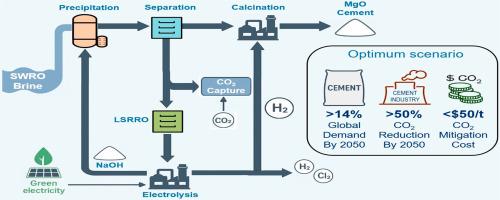当前位置:
X-MOL 学术
›
Water Res.
›
论文详情
Our official English website, www.x-mol.net, welcomes your
feedback! (Note: you will need to create a separate account there.)
Valorising Desalination Brine for Green Cement Production: Toward Mitigating Global CO2 Emissions
Water Research ( IF 11.4 ) Pub Date : 2025-05-29 , DOI: 10.1016/j.watres.2025.123930
Zhiyuan Zong, Omar Daoud, Nicholas P. Hankins, Qianhong She, Christian D. Peters
Water Research ( IF 11.4 ) Pub Date : 2025-05-29 , DOI: 10.1016/j.watres.2025.123930
Zhiyuan Zong, Omar Daoud, Nicholas P. Hankins, Qianhong She, Christian D. Peters

|
Worldwide, 141.5 million cubic meters of brine are produced by desalination plants per day which is usually rejected and discharged into the ocean without further treatment. Even though some research has been done on brine valorisation, the economic and environmental benefits are rarely understood from a global perspective. This work investigates using desalination brine and low-carbon electricity from renewables as the feedstock in a hybrid process integrating membrane concentration, Chlor-Alkali and mineralisation to produce green MgO cement and other valuable by-products. Under the best practical performance of each individual unit operation, our present-day analysis shows that mitigating CO2 by brine utilisation has higher economic competitiveness ($48 to $61.8 per metric tonne of CO2) compared to other CO2 abatement technologies that are currently available. In addition, the capacity of the proposed process, which is attached to the world’s largest seawater desalination plant, can potentially mitigate 5.45 million tons of CO2 per year. Based on this analysis, it is forecast that, when extrapolated globally with required process tuning based on the regional brine variability, the cement production from the brine utilization process has a theoretical maximum capacity to fulfill up to 14-43% of conventional cement production in 2050. To meet the 2050 net-zero emission goal, utilising rejected desalination brine with green electricity could potentially fulfil up to 47.7% of the global carbon capture sequestration task and mitigate 33.3% to 51.3% of CO2 from the cement industry, which represents 2.6% to 4% of global CO2 emissions. This work offers a novel circular economy pathway that transforms desalination brine—a major water industry by-product—into a high-value, low-carbon construction material. The proposed process advances sustainable water management by linking brine treatment with CO₂ mitigation and cement decarbonization.
中文翻译:

为绿色水泥生产评估海水淡化盐水:减少全球二氧化碳排放
在全球范围内,海水淡化厂每天产生 1.415 亿立方米的盐水,这些盐水通常被丢弃并排放到海洋中,无需进一步处理。尽管已经对盐水价值化进行了一些研究,但很少从全球角度理解其经济和环境效益。这项工作研究了在集成膜浓缩、氯碱和矿化的混合过程中使用海水淡化盐水和可再生能源的低碳电力作为原料,以生产绿色 MgO 水泥和其他有价值的副产品。根据每个装置运行的最佳实际性能,我们目前的分析表明,与目前可用的其他 CO2 减排技术相比,通过盐水利用来减少 CO2 具有更高的经济竞争力(每公吨 CO2 48 至 61.8 美元)。此外,拟议的工艺隶属于世界上最大的海水淡化厂,每年可潜在减少 545 万吨二氧化碳。 基于这一分析,可以预测,当根据区域盐水变化进行必要的工艺调整在全球范围内推断时,盐水利用过程的水泥生产理论上的最大产能可以满足 2050 年传统水泥产量的 14-43%。为了实现 2050 年净零排放目标,利用废弃的海水淡化盐水和绿色电力有可能完成高达 47.7% 的全球碳捕获封存任务,并减少水泥行业 33.3% 至 51.3% 的二氧化碳 ,占全球二氧化碳排放量的 2.6% 至 4%。 这项工作提供了一种新颖的循环经济途径,将海水淡化盐水(水工业的主要副产品)转化为高价值、低碳的建筑材料。拟议的流程通过将盐水处理与二氧化碳减排和水泥脱碳联系起来,推进了可持续的水资源管理。
更新日期:2025-05-30
中文翻译:

为绿色水泥生产评估海水淡化盐水:减少全球二氧化碳排放
在全球范围内,海水淡化厂每天产生 1.415 亿立方米的盐水,这些盐水通常被丢弃并排放到海洋中,无需进一步处理。尽管已经对盐水价值化进行了一些研究,但很少从全球角度理解其经济和环境效益。这项工作研究了在集成膜浓缩、氯碱和矿化的混合过程中使用海水淡化盐水和可再生能源的低碳电力作为原料,以生产绿色 MgO 水泥和其他有价值的副产品。根据每个装置运行的最佳实际性能,我们目前的分析表明,与目前可用的其他 CO2 减排技术相比,通过盐水利用来减少 CO2 具有更高的经济竞争力(每公吨 CO2 48 至 61.8 美元)。此外,拟议的工艺隶属于世界上最大的海水淡化厂,每年可潜在减少 545 万吨二氧化碳。 基于这一分析,可以预测,当根据区域盐水变化进行必要的工艺调整在全球范围内推断时,盐水利用过程的水泥生产理论上的最大产能可以满足 2050 年传统水泥产量的 14-43%。为了实现 2050 年净零排放目标,利用废弃的海水淡化盐水和绿色电力有可能完成高达 47.7% 的全球碳捕获封存任务,并减少水泥行业 33.3% 至 51.3% 的二氧化碳 ,占全球二氧化碳排放量的 2.6% 至 4%。 这项工作提供了一种新颖的循环经济途径,将海水淡化盐水(水工业的主要副产品)转化为高价值、低碳的建筑材料。拟议的流程通过将盐水处理与二氧化碳减排和水泥脱碳联系起来,推进了可持续的水资源管理。


















































 京公网安备 11010802027423号
京公网安备 11010802027423号